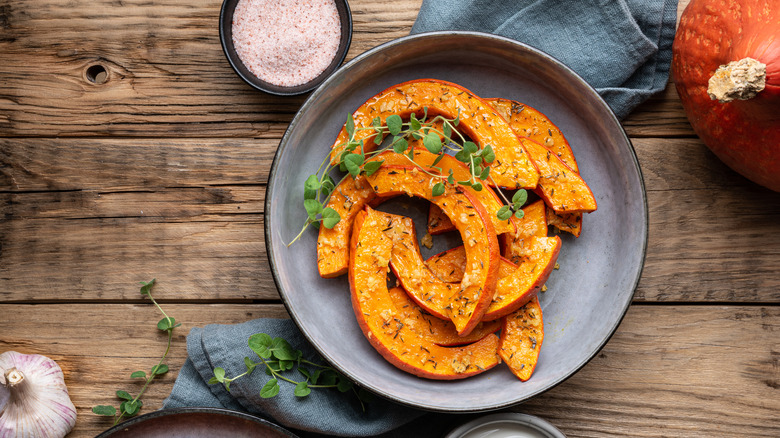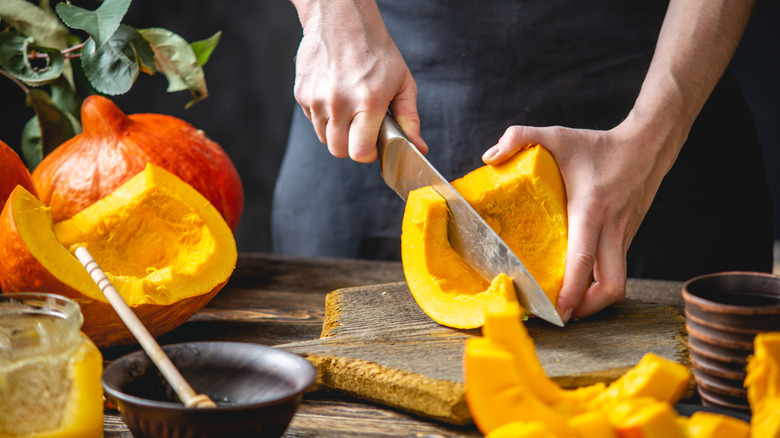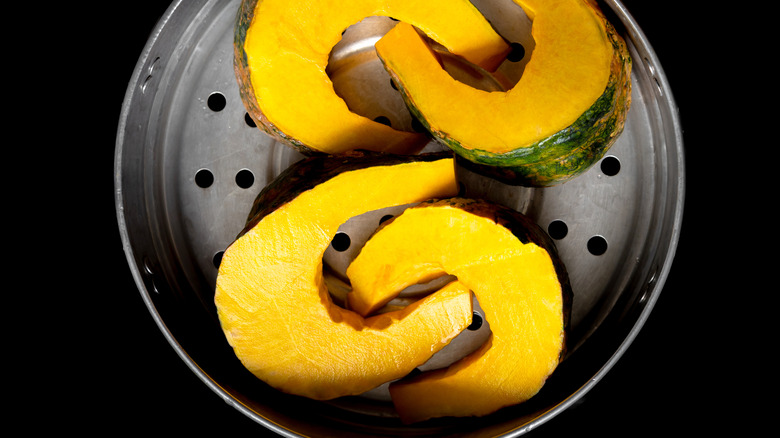Why You Should Use The Microwave The Next Time You Cook With Pumpkin
Ah, the pumpkin. Queen of autumn. It's arguably the most telling sign that fall is upon us. After all, we don't go around splurging embarrassing amounts of money on apple spice lattes. But the pumpkin — a winter squash — has culinary potential that extends far beyond cinnamon-laced pies, breads, and cookies.
In Haiti, for example, pumpkin is blended into joumou, a hearty beef soup eaten to commemorate the country's independence from France (via New York Times). In Iran and Afghanistan, it can be roasted, served with yogurt, and topped with walnuts, according to Bon Appétit. In Brazil, it's used as a bowl for aromatic seafood stews in a way that'll make you forget your Panera bread bowl instantly (via Chowhound). It's no surprise pumpkin plays a role in dishes around the globe: while notably not the most flavorful squash, it's packed with nutritional benefits. As Livestrong notes, boiling pumpkin in water is one common way to cook the supple squash, but we're suggesting you use the microwave to better conserve its nutrients.
A nutrient-rich dish
You retain many nutrients by going with a quicker method of pumpkin preparation. If you've ever been told to eat your carrots because they're good for your eyes (they really are, by the way) then you might want to try adding pumpkin into your culinary routine (via Scientific American). Like carrots, pumpkin is packed with vitamin A. One cup of cooked pumpkin contains around 245% of what the Food and Drug Administration recommends for your daily vitamin A intake, according to Healthline. All that vitamin A can help strengthen your vision in low-light settings, and works to keep your cornea healthy, Medical News Today says.
Pumpkin also has fiber, aiding healthy digestion, and vitamin C, which helps promote skin health. And, the squash contains antioxidants, which may help keep your cells regulated, and could potentially protect against mutation from free radicals (via Mayo Clinic). Are the bananas on your kitchen table still green? Then try incorporating some pumpkin into your next meal for a potassium-rich diet. Healthline estimates a cup of pumpkin contains about 16% of your recommended daily intake for potassium — a banana, by comparison, contains just 9%.
Try the microwave
So if the pumpkin is nutritious enough to possibly achieve superfood status, why not use it more? Livestrong suggests microwaving it, rather than putting it in a pot of boiling water. Heating the squash in water can lessen its nutritional benefits, as vitamins could leak out of the pumpkin and into the water, which inevitably gets dumped down the sink.
This is true of other produce cooked in water — from broccoli to sweet potatoes to peas. In one study conducted by the U.S. Department of Agriculture, leafy greens kept only about 60% of their vitamin C content when cooked in water (via SFGate). Luckily, the microwave option can not only be healthier, but quicker. AllRecipes suggests microwaving the quartered pumpkin for about seven minutes, checking on it, then continuing for another eight minutes. They advise using plastic wrap to prevent the squash from drying out as it cooks. Alternatively, Livestrong suggests quartering the pumpkin, laying the pieces up on a paper towel, and microwaving the squash for five minutes per pound. Frequently rearranging your pumpkin slices can ensure it cooks all the way through.


